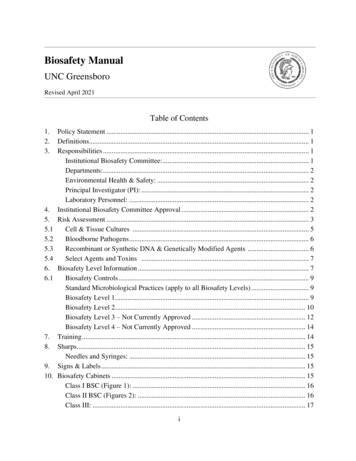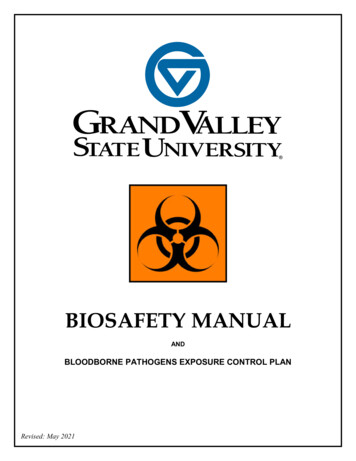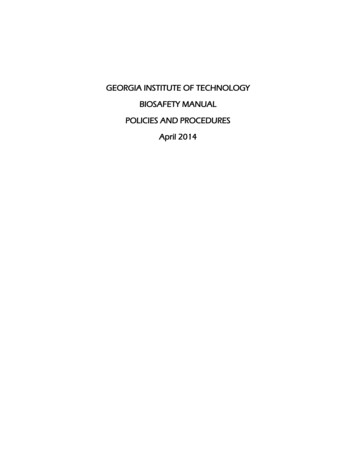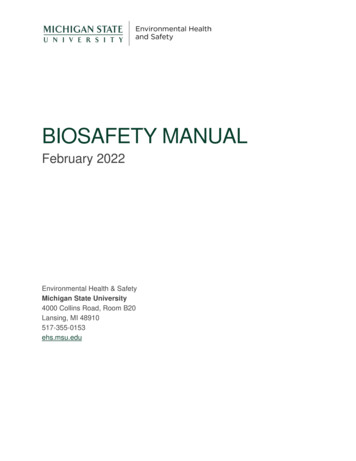
Transcription
BIOSAFETY MANUALFebruary 2022Environmental Health & SafetyMichigan State University4000 Collins Road, Room B20Lansing, MI 48910517-355-0153ehs.msu.edu
TABLE OF CONTENTSContacts . 4Foreword . 5Biohazard Definition . 6Rules, Regulations & Guidelines . 6Risk Assessment . 8Biological Safety and Biosafety Levels . 10The Biosafety Level 1 Laboratory . 16The Biosafety Level 2 Laboratory . 18Biological Safety Level 3 Laboratories . 23Laboratory Animal Facilities . 29Plant Biological Safety Levels . 45Laboratory Biosecurity . 48Safety Equipment . 49Recommended Work Practices . 56Guidelines for Working with Tissue Culture/Cell Lines . 59Guidelines for Preventing the Transmission of Tuberculosis . 60Guidelines for Clinical Laboratories . 60Guidelines for Prion Use . 61Guidelines Regarding Select Agents . 61Guidelines for Handling Exempt Strains of Select Agents . 62Guidelines for the Use of Exempt Levels of Select Agent Toxins. 63Decontamination . 63Biohazardous Waste . 67Biohazard Spill Clean-Up Procedures . 70Handwashing and Hand Decontamination. 73Introduction to the Transport of Biological Substances . 73Use of Animals in Research . 75Use of Human Subjects and Materials in Research . 76Non-Human Primate (NHP) Material Biosafety Hazards . 76Biosafety and Recombinant DNA technology . 78Appendix A – Biosafety Resources . 82Appendix B – Select Agent List DHHS/USDA . 83Appendix C – Risk Assessment Form . 85Appendix D – Examples of RG-2, RG-3, and RG-4 Agents . 88Appendix E – Equipment Release Form . 95Appendix F- Exposure Response Procedure. 96ehs.msu.eduFeb 2022Page 2
Appendix G – Lab and Animal Biosafety Level Summaries . 97Appendix H – Example Inventory Log . 99Appendix I – Biosafety Practices for Handling Prions . 100Appendix J – Requirements for Handling Exempt Strains of Select Agents . 105Appendix K – Site Specific Training Checklist . 110Appendix L – Large Scale Biosafety Guidelines . 112Appendix M – Biosafety Practices for Viral Vectors . 123ehs.msu.eduFeb 2022Page 3
CONTACTSEmergencies: 911In case of emergency:Dial 911Non – Emergency Medical AttentionFaculty, staff and paid student employeesLansing Urgent Carewww.lansingurgentcare.comNon-employee studentsOlin Student Health Centerhttp://olin.msu.edu/(517) 353-5557Or nearest emergency room or after hours urgent care facilityOutside of the Lansing area:Go to the nearest emergency room.Assistance involving occupational, environmental, radiation,chemical and/or biological safetyEnvironmental Health & Safety (EHS)https://ehs.msu.eduMonday – Friday8:00 am – 5:00 pm(517) 355-0153Nights and weekendsMSU Police(517) 355-2221ehs.msu.eduFeb 2022Page 4
FOREWORDThis biosafety manual has been developed by the Environmental Health and Safety (EHS) Department atMichigan State University. The manual is part of MSU's biosafety program, which was established toaccomplish the following goals: Protect personnel from exposure to infectious agentsPrevent environmental contaminationProvide an environment for high quality research while maintaining a safe work placeComply with applicable federal, state and local requirementsThe biosafety manual provides university-wide safety guidelines, policies and procedures for the use andmanipulation of biohazards. Although the implementation of these procedures is the responsibility of thePrincipal Investigator (PI), its success depends largely on the combined efforts of laboratory supervisorsand employees. Planning for and implementation of biological safety must be part of every laboratoryactivity in which biohazardous materials are used.In general, the handling and manipulation of biological agents and toxins, as well as recombinant orsynthetic nucleic acid molecules, requires the use of various precautionary measures depending on thematerial(s) involved. This manual will provide assistance in the evaluation, containment and control ofbiohazards. However, it is imperative that all parties involved or working with these materials seekadditional advice and training when necessary. The EHS is available at MSU to assist in this endeavor.ehs.msu.eduFeb 2022Page 5
BIOHAZARD DEFINITIONBiohazards include infectious or etiologic (disease causing) agents of humans, animals and plants, toxinsof biological origin, human-derived materials, recombinant DNA and any materials potentially containinginfectious agents or biohazards.Biohazardous agents may include but are not limited to: Certain bacteria, fungi, viruses, rickettsiae,chlamydiae, parasites, recombinant products, allergens, cultured human or animal cells and thepotentially infectious agents these cells may contain viroids, prions and other infectious agents asoutlined in laws, regulations, or guidelines.RULES, REGULATIONS & GUIDELINESThe following is a brief summary of the regulatory authorities that either regulate or provide guidelines forthe use of biological materials, infectious agents and recombinant DNA molecules. Copies of thesedocuments are available from the EHS.National Institute of Health (NIH): Guidelines on ResearchInvolving Recombinant or Synthetic Nucleic Acid MoleculesThese guidelines address the safe conduct of research that involves construction and handling ofrecombinant DNA molecules and organisms containing them. In 1974, a recombinant DNA AdvisoryCommittee (RAC) was established to determine appropriate biological and physical containment practicesand procedures for experiments that potentially posed risks to human health and the environment. As aresult of the committee’s activity, the initial version of the NIH Guidelines was published in 1976. It hasbeen amended and revised many times since then. Included in the Guidelines is a requirement for theinstitution to establish an Institutional Biosafety Committee (IBC) with authority to approve or disapproveproposed research using the NIH Guidelines as a minimum standard. For more information, please referto the following section of this manual: Biosafety and Recombinant DNA or Synthetic Nucleic AcidMolecule Technology, the NIH Guidelines for Research Involving Recombinant or Synthetic Nucleic AcidMolecules and the Biosafety in Research website.Biosafety in Microbiological and Biomedical Laboratories (BMBL)In 1984, the Centers for Disease Control and Prevention (CDC) and the National Institute of Health (NIH)published the first edition of the BMBL. This document describes combinations of standard and specialmicrobiological practices, safety equipment, and facilities that constitute Biosafety Levels 1-4, which arerecommended for working with a variety of infectious agents in various laboratory settings. This documentalso outlines requirements for animal biosafety levels. The BMBL has been revised several times and iscommonly seen as the standard for biosafety. MSU is using the BMBL as the basis for this biosafetymanual.Michigan Occupational Safety and Health Administration:Bloodborne Infectious Disease StandardIn 1992, the Occupational Safety and Health Administration (OSHA) promulgated a rule to deal with theoccupational health risk caused by exposure to human blood and other potentially infectious materials.OSHA’s rule includes a combination of engineering and work practice controls, personal protectiveclothing and equipment, training and medical follow-up of exposure incidents, vaccination, and otherprovisions. The Michigan Occupational Safety and Health Administration (MIOSHA) enforced its standardehs.msu.eduFeb 2022Page 6
for Bloodborne Infectious Diseases in 1993. Consequently, MSU established an Exposure Control Plan toprotect employees at MSU from exposure to HIV, Hepatitis B and other bloodborne pathogens. For moreinformation, please refer to the MSU Exposure Control Plan.OSHA StandardMIOSHA StandardDepartment of Health and Human Services (HHS) Possession,Use, and Transfer of Select Agents and ToxinsIn 1996, HHS published a set of rules that require facilities and institutions to be registered and approvedin order to transfer or receive certain biological agents and toxins. These rules have been revised severaltimes since then. HHS requires MSU to comply with the BMBL (see above) and OSHA’s LaboratorySafety Standard 29 CFR 1910.1450. A copy of the most current list of restricted agents and toxinscovered under this rule is included in Appendix B.United States Department of Agriculture (USDA) Possession,Use, and Transfer of Biological Agents and ToxinsAgricultural Bioterrorism Protection Act of 2002; United States Department of Agriculture (USDA)The USDA has also established a set of rules that require facilities and institutions to be registered andapproved in order to transfer or receive certain biological agents and toxins. A copy of the most currentlist of restricted agents and toxins covered under this rule is included in Appendix B. Select Agents andToxins RulesMichigan Department of Public Health: Michigan Medical WasteRegulatory Act (MMWRA)In 1990, the MMWRA was promulgated to establish a program regulating the handling and disposal ofmedical waste. The rule mandates how producing facilities (generators of medical waste) must handlemedical waste from the point at which it becomes medical waste, to the point of its ultimate disposal.MSU’s compliance with this Act is outlined in the MSU Biohazardous Waste Management Plan, which isused in conjunction with the MSU Hazardous Waste Disposal Guide.Packaging, shipment and transportation requirements forinfectious substances, diagnostic specimens, biological productsand genetically modified organismsPackaging, shipment and transportation requirements for infectious substances, diagnostic specimens,biological products and genetically modified organisms are addressed in the following rules andguidelines: United NationsRecommendations of the Committee of Experts on the Transportation of Dangerous Goods International Civil Aviation Organization (ICAO)Technical Instructions for the Safe Transport of Dangerous Goods by Air International Air Transport Association (IATA)ehs.msu.eduFeb 2022Page 7
Dangerous Goods Regulations U.S. Department of Transportation49 CFR Parts 171-178 U.S. Public Health Service42 CFR Part 72 U.S. Postal Service39 CFR Part 111 U.S. Department of Labor, OSHA29 CFR 1910.1030Importation permits are required for certain infectious agents,biological materials and animalsImportation permits are required for certain infectious agents, biological materials and animals as outlinedin U.S. Public Health Service, 42 CFR Part 71, Foreign Quarantine. In addition, the Department ofAgriculture (USDA) Animal and Plant Health Inspection Service (APHIS) requires permits for importationand transportation of controlled materials, certain organisms or vectors. This includes animal and plantpathogens, certain tissue cultures and live animals. APHIS also regulates the importation, interstatemovement, or environmental release of genetically engineered organisms as regulated under 7 CFR Part340.RISK ASSESSMENTRisk assessment is a process used to examine the various factors associated with a procedure involvingbiological materials in order to identify the hazardous characteristics of the material, the activities that canresult in a person’s exposure to an infectious agent, the likelihood that exposure will cause a laboratoryacquired infection, and the probable consequences of an infection. The information identified by riskassessment will provide a guide for the selection of biosafety levels, microbiological practices, safetyequipment, and facility safeguards that can prevent laboratory acquired infections and reduceenvironmental contamination risk. Please refer to Appendix C for a form to assist with risk assessments.Factors to consider in a risk assessment include both agent hazards and laboratory procedure factors.Agent Hazards: Capability to infect and cause disease in a susceptible hostVirulence as measured by the severity of diseaseAvailability of preventive measures and effective treatments for the diseaseProbable routes of transmission of laboratory infectionThe predominant routes of transmission in the laboratory include mucous membrane exposure,parenteral inoculation, ingestion and inhalation of infectious aerosols.Infective doseStability in the environmentHost rangeIts endemic natureReports of laboratory acquired infectionsOrigin of the agentehs.msu.eduFeb 2022Page 8
Classification of Infectious Agents on the Basis of Hazard (Risk Groups)Risk groups (RG) are a method used by the World Health Organization (WHO) and by the NationalInstitutes of Health (NIH) to classify human etiological agents based on hazard to both the individual andto the community. There are four risk groups. These correlate to but are not equivalent to biosafetylevels. Determining the risk group of a biological agent can be part of the biosafety risk assessment andhelps in assigning the correct biosafety level for containment. In general, RG-2 agents are handled atBSL- 2, and RG-3 agents at BSL-3. However, the use of certain RG-2 agents in large quantities mightrequire BSL-3 conditions, while some RG-3 agents may be safely manipulated at a BSL-2 under certainconditions.Table 1: Basis for the Classification of Biohazardous Agents by Risk GroupRisk GroupRisk to the individual and the communityRisk Group 1(RG-1)Risk Group 2(RG-2)Risk Group 3(RG-3)Risk Group 4(RG-4)Agents that are not associated with disease in healthy adult humans (no orlow individual and community risk).Agents that are associated with human disease which are rarely seriousand for which preventive or therapeutic interventions are often available(moderate individual risk but low community risk).Agents that are associated with serious or lethal human disease for whichpreventive or therapeutic interventions may be available (high individualrisk but low community risk).Agents that are likely to cause serious or lethal human disease for whichpreventive or therapeutic interventions are not usually available (highindividual risk and high community risk)Examples of RG-1 agents include microorganisms like Escherichia coli-K12 or Saccharomycescerevisiae. A list of Risk Group 2, 3 and 4 agents can be found in Appendix D. It is important to notehowever, that no list is all inclusive. Also, those agents not listed in RG-2, RG-3 or RG-4 are notautomatically classified in RG-1. Those unlisted agents need to be subjected to a risk assessment basedon the known and potential properties of the agents.Hazards of Genetically-Modified AgentsWhen conducting a risk assessment of genetically modified agents, consideration of the same factorsused in risk assessment of the wild-type organism should be done. However, it is important to addressthe possibility that the genetic modification could alter (i.e., increase or decrease) the pathogenicity of theagent or affect its susceptibility to antibiotics or other treatments. Sometimes, important information maynot be available for a newly engineered agent and the risk assessment may be difficult or incomplete. Inthese cases, due diligence should be practiced and the biosafety level assignment should be madeconservatively. Once more information is available another risk assessment should be completed.Hazards of Cell CulturesHuman and animal cells and tissues have the potential to harbor latent infectious agents and personnelwho handle these materials are at risk for possible exposure. For additional information andrequirements for working with human cell cultures please refer to the MSU Exposure Control Plan and tothe following section of this manual: Guidelines for Working with Tissue Culture/Cell Lines.ehs.msu.eduFeb 2022Page 9
Laboratory Procedure Hazards Parenteral inoculationsInjection of potentially hazardous materials can occur by a needle, other contaminated sharp orby bites from infected animals or arthropod vectors.Spills and splashes into skin and mucous membranesMucous membranes include the eyes, nose and mouth.Ingestion through mouth pipettingAnimal bites and scratchesInhalation exposures to infectious aerosolsAerosols, or respirable sized particles, are extremely hazardous because they are generated inmany lab procedures and are usually undetected. The creation of infectious aerosols places theperson carrying out the procedure and others in the laboratory at risk. Any procedure that breaksthe surface tension of a liquid will produce aerosols. Pipetting, blenders, non-selfcontainedcentrifuges, sonicators and vortex mixers all produce aerosols. Procedures and equipment thatcreate aerosols also create larger droplets that rapidly settle out of the air. These droplets cansettle on surfaces and therefore contaminate gloved hands, work spaces and mucousmembranes.BIOLOGICAL SAFETY AND BIOSAFETY LEVELSBiological safety is the application of knowledge, techniques and equipment to prevent personal,laboratory and environmental exposure to potentially infectious agents or biohazards. Biosafety definesthe containment conditions under which infectious agents can be safely manipulated. The objective ofcontainment is to confine biohazards and to reduce the potential exposure of the laboratory worker,persons outside of the laboratory, and the environment to potentially infectious agents. It can beaccomplished through the following means:Primary Containment: Protection of personnel and the immediate laboratory environment through goodmicrobiological technique (laboratory practice) and the use of appropriate safety equipment.Secondary Containment: Protection of the environment external to the laboratory from exposure toinfectious materials through a combination of facility design and operational practices.Combinations of laboratory practices, containment equipment, and special laboratory design can bemade to achieve different levels of physical containment. Currently four biosafety levels (1- 4) define thelevels of containment necessary to protect personnel and the environment. A biosafety level 1 (BSL-1) isthe least restrictive; while biosafety level 4 (BSL-4) requires a special containment laboratory or facility,which is not available at MSU. Since most of the research at MSU is conducted at biosafety levels 1 and2 with few experiments at BSL-3, this manual will mainly focus on these three biosafety levels. For moreinformation on biosafety level 4 requirements refer to the appropriate literature or contact the BiologicalSafety Officer. A summary of the different biosafety level requirements can be found in Appendix G.The most important element in maintaining a safe work environment is strict adherence to goodmicrobiological and laboratory practices and techniques. Everyone working with infectious agents orpotentially infectious materials must be aware of the potential risks. In addition, they must be trained andproficient in the practices and techniques required for handling such material. It is the responsibility of thePrincipal Investigator or person in charge of the laboratory to provide or arrange for appropriate training ofall personnel.General Laboratory PracticesThe following information applies to all laboratories housing biological materials. Information for specificbiosafety levels will follow.ehs.msu.eduFeb 2022Page 10
Routes of InfectionAn infection occurs when disease-causing microorganisms enter the human body in sufficient numbersand by a particular route and overcome the body's defense system. The following routes of infection havebeen reported for laboratory-acquired infections:1. Through the mouth Eating, drinking and smoking in the laboratory Mouth pipetting Transfer of microorganisms to mouth by contaminated fingers or articles2. Through the skin Accidental inoculation with a hypodermic needle, other sharp instrument or glass Cuts, scratches3. Through the eye Splashes of infectious material into the eye Transfer of microorganisms to eyes by contaminated fingers4. Through the lungs Inhalation of airborne microorganismsMost of the laboratory-acquired infections reported in the literature point to accidents during work withsome type of infectious agent. These include spills, splashes and accidents involving needles or othersharp objects. The general laboratory procedures outlined in this manual address those issues andprovide for guidance in handling infectious or potentially infectious materials.AccessWhen procedures are in progress, the lab door should be shut and when no one is present in the lab thedoors should be locked. Anyone requesting access to the laboratory should be questioned as to theirpurpose and identification should be provided.Biohazard Warning SignA biohazard label is required for all areas or equipment in which RG-2 or higher agents are handled orstored or where BSL-2 or higher procedures are required. Labels should be posted at the main entrancedoor(s) to laboratories and animal rooms, on equipment such as refrigerators, freezers, biological safetycabinets, incubators, and transport containers. Labels and door signage are to be obtained from the EHS(355-0153).Signage for BSL-2 or higher labs must include the following information: Biosafety level Supervisor’s or other responsible person’s name Telephone number Procedures required for entering and exiting the labPersonal Protective Equipment (PPE)Personal protective equipment is used to protect personnel from contact with hazardous materials andinfectious agents. Appropriate clothing may also protect the materials from contamination. Personalehs.msu.eduFeb 2022Page 11
protective devices and safety equipment as well as training in the proper use of those devices andequipment, must be provided to all employees under the appropriate circumstances. The employeeshave the responsibility of properly using the equipment.Eye and Face ProtectionSafety glasses must be worn in the lab whenever procedures are underway involving a low probability ofsplash, work with low hazard chemicals, or an impact hazard.Whenever possible, lab operations should be performed in containment devices such as a biologicalsafety cabinet or fume hood, or behind a bench-top shield in order to minimize the potential for skin ormucous membrane contact with a hazardous splash. If procedures do not permit containment of thehazard with a containment device, then appropriate PPE must be worn as outlined: Splash goggles are the only form of eye protection approved for splash hazards. If a chemical(including bleach) or biological splash hazard exists, splash goggles must be worn.Full face protection (i.e., face shield) must be used for procedures that have anticipated splashes orsprays of infectious or other hazardous materials to the face or if there is a high potential for aerosolgeneration. Face shields are not a replacement for eye protection. Refer to the EHS ChemicalSafety website for further information regarding eye & face protection.Information on the availability of low cost prescription safety eyewear may be obtained by calling theEHS at 355-0153.Laboratory ClothingThis category includes laboratory coats, smocks, scrubs, and gowns. Long-sleeved garments should beused to minimize the contamination of skin or street clothes. In circumstances where it is anticipated thatsplashes may occur, the garment must be resistant to liquid penetration. If the garment is not disposable,it must be capable of withstanding sterilization, in the event it becomes contaminated. The garmentshould be flame resistant when working with or around open flames or high temperature heat sources.A laboratory coat is recommended for all work at BSL-1 and it or other suitable protective clothing isrequired when handling potentially infectious materials at BSL-2 or higher. Additional criteria for selectingclothing are: comfort, appearance, closure types and location, antistatic properties and durability.Protective clothing must be removed and left in the laboratory before leaving for non-laboratory areas.Disposables should be available for visitors, maintenance and service workers in the event it is required.All protective clothing should be either discarded in the laboratory or laundered (Department facilities orMSU’s laundry – Spartan Linen Services). Personnel must not take laboratory clothing home. Long hairand loose clothing (like neck ties, dangling jewelry, scarves, or long sleeves) should be secured to avoidcontamination and material getting caught in equipment.GlovesGloves must be selected based on the hazards involved and the activity to be conducted. Gloves must beworn when working with biohazards, toxic substances, hazardous chemicals and other physicallyhazardous agents. Temperature resistant gloves must be worn when handling hot material or dry ice.Delicate work requiring a high degree of precision dictates the use of thin walled gloves.When latex gloves have been chosen, alternatives should be made available. Gloves should be changedas soon as possible after they have become contaminated; when their integrity has been compromised orwhen necessary. Hands should be properly washed with soap and water after removing gloves.Disposable gloves must not be washed or reused and should be disposed of as soon as removed.ehs.msu.eduFeb 2022Page 12
Gloves should be removed and hands washed when work with potentially infectious materials is completeor when leaving the laboratory. If you are transporting potentially infectious materials (i.e., cultures,waste, etc.) to another part of the building use the one glove rule: use one gloved hand for handling thematerials and use the other ungloved hand for touching common surfaces such as door knobs ande
BIOSAFETY MANUAL . February 2022. Environmental Health & Safety . Michigan State University . 4000 Collins Road, Room B20 . Lansing, MI 48910 . 517-355-0153
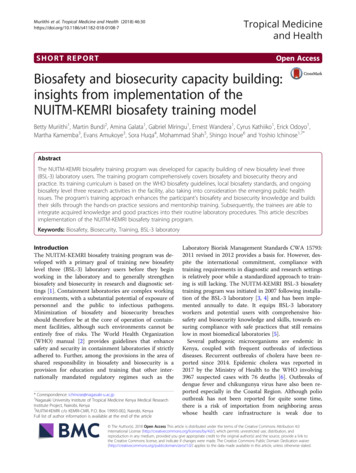
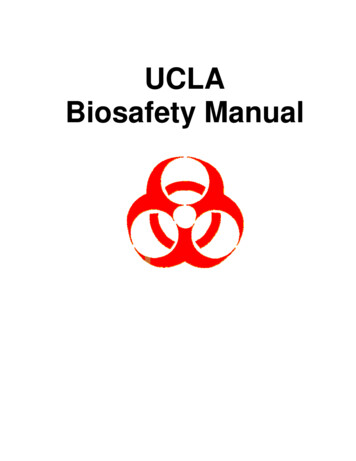
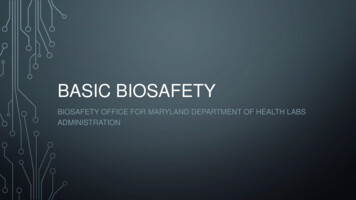
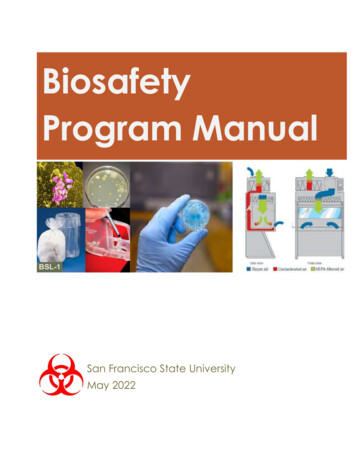
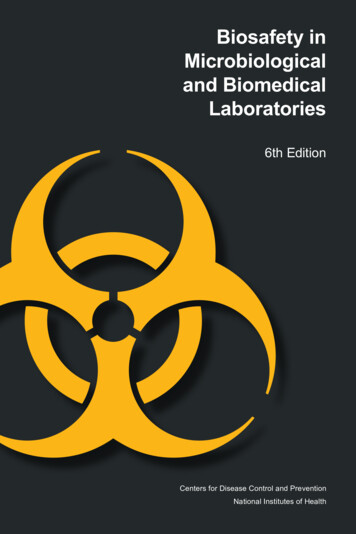
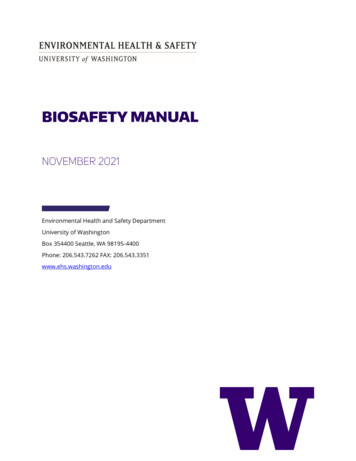
![Biosafety Manual University of Colorado Boulder 120621[80]](/img/25/biosafety-manual-university-of-colorado-boulder.jpg)
